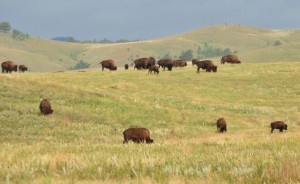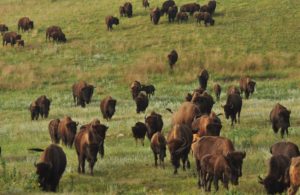Photography courtesy of Lowell Washburn, all rights reserved.
Late August and I’m sitting on a hillside in
Custer State Park’s southern prairie. As is the case with most folks who
visit this state park each year — [1.8 million in 2012] — I’ve come to see
the bison.
The timing is perfect. The raucous all night revelry of the annual
Sturgis Motorcycle Rally is past, while the guided tour-bus congested,
three-ring-circus atmosphere of the September Buffalo Roundup is yet to
come. For the time being, at least, solitude abounds.
My parents first brought me to this spot in 1958. Ever since, I’ve been
coming back, and back, and back. Regardless of how many times I return to
this 71,000-acre park paradise, the bison watching never gets old; never gets
boring. Like snowflakes, no two days are exactly the same. Always
something new to see.

In addition to seeing, there are also sounds. Sounds of coyotes, sounds
of prairie dogs, the sharp overhead scream of an adult golden
eagle. But there is one sound that easily overshadows all others.
That sound is the distinctive roar of the mature bison bull. The roar of
the bison is unique, impressive, and frustratingly impossible to describe.
Built along the lines of a low slung, four-wheel-drive, 2,000 pound locomotive;
mature bulls have a gargantuan set of lungs and, therefore, are endowed with a
huge and deep chest cavity. The roar begins from somewhere deep inside
this chest. Aided by the bull’s flexible diaphragm, the rumble
slowly builds to a crescendo before exiting at the end of the bison’s massive
windpipe. Once heard, the sound is never forgotten. When heard at
close range from an approaching bull you didn’t realize was just over the hilltop
— Well, let’s just say that the sound promotes a hasty departure.
Peak roaring — and fighting — occurs during the summer rut. For the
most part, the rut is winding down now. But although the dramatic and
dusty fighting may be past, mature prime-of-life bulls are still roaring from
daylight to dusk. A number of late heifers are still coming in season —
an event which is certainly helping bulls to maintain their competitive
spirits.

But the August prairie has more to offer than sight and sound. Even the
smells associated with bison can provide a uniquely memorable experience.
That’s right — even the smells. A few days ago, I was sitting about 60
yards downwind from a herd containing a couple of hundred cows and calves as
well as several mature [roaring] bulls. Temperatures were warming and the
early afternoon breeze was on the rise. With that breeze came the smell
of bison. Although the smell was reminiscent of domestic cattle on good
pasture, the breeze actually carried much more. Mingled with the smells
of grazing bovines and fresh droppings came the distinctive aroma of virgin
prairie. The smells included a rich combination of sage, ripened cone
flower, goldenrod and a large variety of other plants whose pent up aromas had
been suddenly released into the atmosphere by the crushing effect of hundreds
of sharp edged hooves. Fragrant to the verge of overpowering, the aroma
was pure ambrosia. If I could have figured out a way to bottle it, I
would have brought some home.
Realizing that this pleasing phenomena was the result of a mere 200 or so
grazing animals, I couldn’t help but wonder what the aroma would have been like
when unfathomable numbers of American bison freely roamed the Dakota
prairies. As is the case with the bison’s distinctive roar, I’m guessing
the intensity of that fragrance would have been impossible to adequately
describe. Although I haven’t discovered any historic content regarding
the ‘smells’ associated with those early days on the Western bison range; I
have attached some favorite and historic, first person accounts of what it was
like to be on the prairie when dozens of mounted, bow wielding human hunters
rode into the dusty midst of terror stricken, stampeding bison. Also
attached are photos from the modern-day Custer bison herd. The photo
captioned “Prairie Locomotive” is a portrait of the largest bison
I’ve ever seen anywhere. Currently in his prime, I’m guessing the bull
could realistically tip the scale at 2,200 pounds — maybe more.



 Tom Cope
Tom Cope Sue Wilkinson
Sue Wilkinson Susan Judkins Josten
Susan Judkins Josten Rudi Roeslein
Rudi Roeslein Elyssa McFarland
Elyssa McFarland Mark Langgin
Mark Langgin Adam Janke
Adam Janke Joe Henry
Joe Henry Kristin Ashenbrenner
Kristin Ashenbrenner Joe Wilkinson
Joe Wilkinson Dr. Tammy Mildenstein
Dr. Tammy Mildenstein Sean McMahon
Sean McMahon